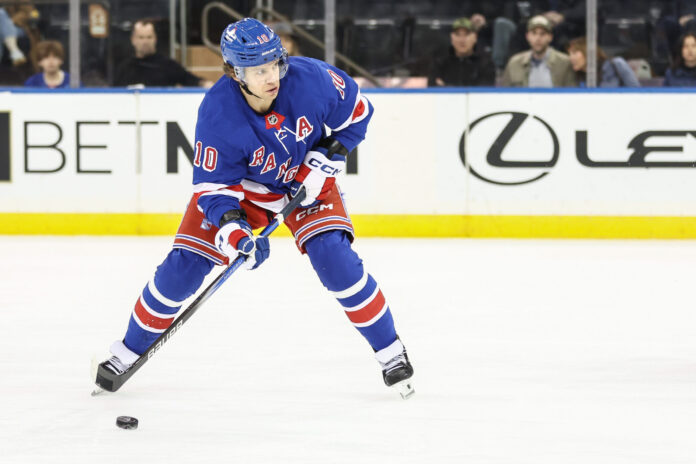The biggest question about this Rangers offseason will be how the Rangers manage their three-headed hydra of Artemi Panarin, Mika Zibanejad, and Chris Kreider. The Rangers need to make changes and while running it back is a real possibility, it’s far from ideal. While the rumor mill suggests Kreider is almost guaranteed to be traded, it’s not a full guarantee anymore. In fact, trading Artemi Panarin may wind up as the only big move the Rangers make this offseason.
Before Mike Sullivan was brought on board, it was a foregone conclusion that Kreider was going to be traded. Sully has verbalized his enthusiasm for working with the players he coached at the Four Nations, Kreider included, so now this isn’t the foregone conclusion it once was. There’s a strong argument that trading Artemi Panarin is the better choice, though it is not without risk.
Pros of trading Artemi Panarin
We “know” that at least one of the big-three will be traded. Trading Artemi Panarin frees up the most immediate cap space at $11.6 million, which almost doubles the Rangers available cap space this summer from approximately $13.7 million to approximately $25.3 million. Given their need to lock up Will Cuylle–preferably long term– and K’Andre Miller, the extra money goes a long way.
The extra cap space from trading Artemi Panarin could be used in additional trades to bring in a higher salary player, possibly Marco Rossi from Minnesota. It would also give them the wiggle room to bring in a defenseman like Vlad Gavrikov from LA, who is hitting unrestricted free agency as arguably the best LD available. The 29 year old defenseman is projected to get a 4 year contract in the $5.6 million range, per Evolving-Hockey.
Trading Artemi Panarin also frees up a wing spot in the top-six for Gabe Perreault and/or possibly Mika Zibanejad, should he remain on JT Miller’s wing. Perreault, who can play both wings, was already looking good in the top-six, and arguably left three assists on the table in his first game thanks to poor finishing. Zibanejad has already looked revived on Miller’s wing, though he could still thrive at center under Sullivan’s tutelage. It provides options and flexibility, both in roster and cap space.
Expanding on wing spots, the Rangers–in the scenario where they are trading Artemi Panairn–would be left with Perreault, Kreider, Will Cuylle, Alexis Lafreniere, and possibly Zibanejad, Brennan Othmann, and Brett Berard as top-nine wingers. Perreault, Lafreniere, Cuylle, and Othmann and all play both wings. This doesn’t include Arthur Kaliyev, as his fate is still to be determined.
Cons of trading Artemi Panarin
The cons of trading Artemi Panarin are pretty straight forward. He’s an elite, top line winger who would easily be the best player in any trade. The Rangers would be hard pressed to replace his production, though we can dive into our Moneyball quotes as the Rangers attempt to replace him in the aggregate. That’s roughly 40 goals and 90 points that would need to be replaced. Even with a rebounding Kreider and Zibanejad, that’s about 25 goals and 50 points that would need to be replaced by someone under the age of 25.
Trading Artemi Panarin may also signal that the Rangers are willing to “competitively punt” this upcoming season. They won’t tank, and Sullivan is likely more than enough to get the Rangers into the top-three in a pretty atrocious Metro Division. That’s enough to justify keeping the 12th overall pick this draft, but not enough to truly be a contender without Panarin. If the Rangers want to compete for a Cup, then they likely want to keep Panarin and look to move on from one or both of Zibanejad or Kreider.
The other issue with trading Artemi Panarin is his pesky no-move clause. It doesn’t mean he can’t or won’t be traded, it means it complicates things. Given all the locker room drama both on and off the ice, it might be an easier sell to get Panarin to waive his clause to the right team. Unfortunately, we don’t know where he’d accept a trade. For now, we just wing it with guesses like Anaheim and reuniting with Joel Quenneville.
Nothing is done in a vacuum
The good news is that if the Rangers wind up trading Artemi Panarin, there will be subsequent moves to follow. While moving him may be the only major move, the extra cap space would be used to add critical middle-six pieces to both balance out the scoring and help with overall two-way play. Perhaps some of the space is even used to clean up the train wreck of a blue line they are currently projecting for opening night.
While trading Panarin likely means the Rangers won’t be true Cup contenders next season, it opens the door for them to retool on the fly with pieces that would help them beyond the 2025-2026 season. Cap space is king for the Rangers as they look to transition away from the previous core. Moving their most expensive asset could be a step in the right direction, even if it looks like a step back initially.





















